
When we are explaining the Tides, or anything else, to somebody, the sort of explanation we give will depend upon who we are giving it to. If we are playing on a sandy beach with a five year old boy and he asks us why the beach is smaller now than it was when we first went on to it we shall give one explanation; if we are explaining the tides to an intelligent fifteen year old student taking a science exam we shall need to give a totally different explanation. Such an explanation should include why we get two tides a day, and why the phase of the Moon affects the height of the tides.
The Earth’s tides are caused by the gravity of the Sun and the Moon, the movement of the Earth round the Sun and of the Moon round the Earth, and the rotation of the Earth on its axis. All of these are important. Unfortunately many standard explanations in books, including many school text books, and on the internet do not understand this; as a result we are offered explanations which would actually give us only one tide a day, or even only one tide a month.
The tides affect all living things on this Planet, even those that live hundreds of kilometres from the sea. This is more fully discussed later on this Page.
None of the diagrams on this Page are to scale: you can find out why it is quite impossible to make a scale drawing of the solar system by going to The Size of the Solar System Page.
Both the Sun and the Moon influence the tides, but the tides are easier to understand if we consider the influence of the Sun first.

It may not be obvious to you now why what follows is relevant to the tides, but I hope that all will be revealed as you read on.
Newton’s Theory of Gravity says that everything in the Universe is attracting everything else. The force of gravity between two objects is given by

The Universal Gravitational Constant is very, very small indeed. This means that the force of gravity between two bodies is also very, very small indeed unless one of them is very large, for example the Sun or the Earth or the Moon, or they are very close together, for example atoms or molecules. There is a gravitational attraction between you and me, but it is far far too small for either of us to notice it (fortunately). The Earth is very big which is why you do feel the force of gravity between you and the Earth - it is called your weight!
Newton’s First Law of Motion says that a body continues in a state of rest or uniform motion in a straight line unless it is acted upon by an external force. This means that we need a force to make something move in a circle. You can feel this force for yourself by tieing something (something soft please) onto the end of a piece of string and spinning it round in a circle. The force in the string can be several times the weight of the object.

We often refer to this force as a g-force. A force on you of 1 g (for gravity) is your weight, so a force of 3 g means that the force acting on you is three times your weight. If you are not strapped into a car when it goes round a bend too fast you may get flung against the side of the car, or even out of it, by the g-force. Actually, you keep going in a straight line while the car goes round the bend, even if that is not what it feels like. There is no force trying to throw you out of the car, what you feel is the force trying to stop you from being thrown out, so that you move in a circle with the rest of the car rather than in a straight line. Similarly on a loop-the-loop roller-coaster, as you go round the top of the loop you must be going so fast that the g-force you feel acting on you, pushing you into your seat, is greater than your weight. Otherwise you will fall out. In the same way, if you take a glass of water and stir it until the water is rotating you will see that the water moves towards the side of the glass: the water level is higher at the outside than in the middle, because the water near the side of the glass is moving faster than the water in the middle. Only the side of the glass stops the water from going on in a straight line into the room. In a spin-dryer the drum keeps the clothes in the dryer going in a circle but the holes in the drum allow the water to go in a straight line.
We often refer to the g-force that we can feel acting outwards, away from the centre of the circle, on us as we move in a circle as the centrifugal force (from the Latin for fleeing from the centre), but physicists prefer to call the force acting inwards, towards the centre of the circle, which is needed to keep us moving in a circle the centripetal force.
The centripetal force is given by

The Earth is moving round the Sun: the centripetal force that keeps it in orbit is the gravitational attraction between the Sun and the Earth. The only reason why the Earth does not fall into the Sun or go off into space is because the centripetal force needed to keep it moving in a circle round the Sun is exactly equal to the force of gravity between the Earth and the Sun.
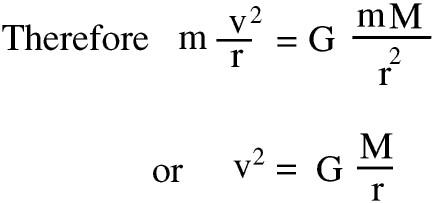
where G is the Universal Gravitational Constant, M is the mass of the Sun, m the mass of the Earth, and r the distance between them. Because m is on both sides of the equation we can cancel it out (also an r), and this means that the orbit of the Earth, or any other body, going round the Sun does not depend on its mass. So all bodies at the same distance from the Sun go round it at the same speed. The asteroid belt consists of millions of lumps of rock all different shapes and sizes, from less that a metre to more than 100 km across, but all going round the Sun at almost exactly the same distance from it, and so all at almost exactly the same speed, in orbits in a very narrow belt between the orbits of Mars and Jupiter.
The Earth is going round the Sun. The Earth is solid but the oceans are not: the water in them is free to move. This means that each individual drop of water in the oceans moves in its own orbit round the Sun, like individual asteroids.

In the time it takes the Earth to move to Position 2 Drop B will move further than Drop A, and Drop A will move further than Drop C, so the speed of the drops increases with distance from the Sun.
Drop A is acted upon by the gravity of the Sun and the Earth, but these act at right angles to each other, so the centripetal force pulling it towards the Sun and keeping it in its orbit is due only to the Sun’s gravity. But for Drop B the gravity of the Earth is added to the gravity of the Sun pulling it towards the Sun. In order to keep the force pulling it towards the Sun exactly equal to the centripetal force needed to keep it in orbit round the Sun Drop B must be slightly further from the centre of the Earth than Drop A: this makes it further from both the Earth and the Sun (so reducing the pull of their gravity) and also makes it travel faster (so increasing the centripetal force needed). The maths involved is not difficult but, because some of the numbers involved are very very big and others are very very small, you need to work to a greater accuracy than is possible with a pocket calculator. You can find the maths on this rather more technical Tides Web Site.
What this means is that there is a bulge in the oceans on the side of the Earth facing away from the Sun.
In the same way, the gravity of the Sun and Earth act in opposite directions on Drop C, and so its orbit round the Sun must take it nearer to the Sun and further from the Earth, so producing a bigger force pulling it towards the Sun, a smaller force pulling it towards the Earth, and a lower speed. So there is a second bulge in the oceans, this time on the side of the Earth facing the Sun. The maths shows that these bulges are equal.
Many books and web sites explain the tides only in terms of the Sun and Moon attracting the oceans. It is of course true that the Sun and Moon do attract the oceans but, apart from being wrong, the way this explanation is usually presented would only give one bulge and so one tide every day, or even only one tide every month. But it is wrong because the Sun attracts the whole of the Earth not only the oceans: the only reason why the Earth and the oceans have not fallen into the Sun long ago is because the Earth is in orbit round it. The motion of the Earth round the Sun is an essential part of our understanding of the tides.

Similarly the Moon is going round the Earth. We can show that this produces two bulges, as for the Sun. The Earth is much nearer the Moon than the Sun, so the Moon Bulges are about three times bigger than the Sun Bulges, but I talked about the Sun Bulges first because I think this makes the whole subject easier to understand.
The mathematics is however more complicated than that for the Sun, and is beyond the scope of this Page. This is because the Sun is very, very much bigger than the Earth and the other Planets, so they all move in circles round it. Similarly Jupiter is very, very much bigger than all its moons so they all move in circles round it.
Sometimes however in astronomy we have two stars or planets of about the same mass moving not one in a circle about the other but both in circles about their common centre of gravity. Astronomers call this arrangement a binary star or binary planet.
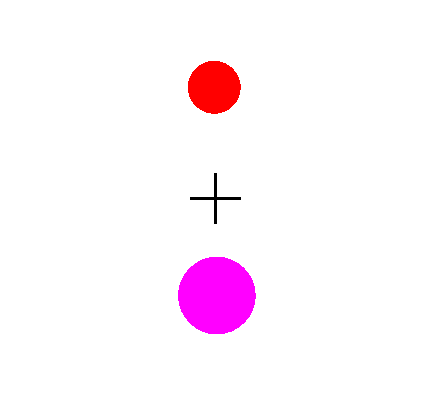
If these two planets each had oceans they would each have two bulges, one pointing towards the other planet and one pointing away from it.
Unlike Jupiter or any other planet and its moons, the Earth is not very, very much more massive than the Moon, in fact it is only about seven times as massive, and this means that the centre of gravity of the Moon and Earth together is a long way from the centre of the Earth (but still inside it). We talk about the Moon going round the Earth, but in fact they are both rotating about their common centre of gravity: Martian children learning about the Solar System would be taught that between Venus and Mars there is a binary planet.
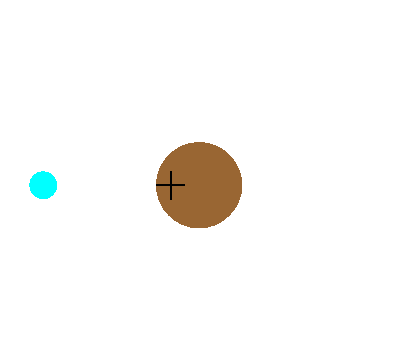

The Earth rotates on its axis about once every twenty four hours. As it rotates the Moon Bulges stay pointing towards and away from the Moon.
For clarity this diagram shows only the Moon Bulges, and the Moon going round the centre of the Earth, and also only one tide cycle.
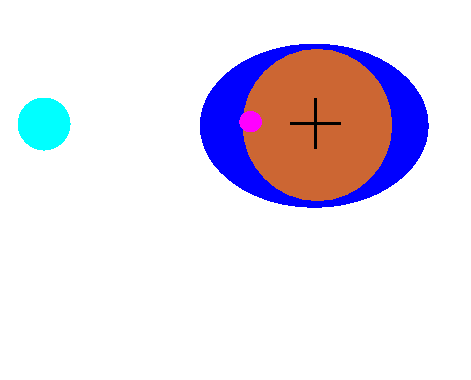
This diagram starts with a certain point, our point, on the Earth's surface under the Moon. The water height at this point will be a maximum (High Tide). As the Earth rotates the height of water at this point will get less, reaching a minimum value after about six hours (Low Tide), then increase to a maximum value after about twelve hours (High Tide again), then get less again (Low Tide again), and then return to its original value (High Tide again). This cyclic change of the height of the water at any point on the Earth’s surface gives the ebb and flow (going out and coming in) of the tides. The ebb and flow of the tides is caused not by the Moon going round the Earth but by the Earth rotating on its axis.
Of course as well as the Earth rotating on its axis the Moon is going round the Earth, about once every twenty eight days, so in the time it takes for the Earth to turn once on its axis the Moon will have moved round the Earth a little, so the time taken for our point to return to its original point under the Moon will be slightly longer than twenty four hours. It is actually about 24 hours 25 minutes, so the time of High Tide at any point on the Earth’s surface gets later by about 25 minutes every day.
In the same way, in the time taken for the Earth to rotate once on its axis it will have moved very slightly in its orbit round the Sun. A day of twenty four hours is the time taken for the Sun to return to the same position in the sky, and this is very slightly longer than the time taken for the Earth to rotate on its axis. The actual time for the Earth to rotate once is 23 hours 56 minutes 4.09 seconds. This is more fully discussed in the Page on the Orbit of the Earth.
As the Moon goes round the Earth it crosses the line between the Earth and the Sun. This is when a New Moon occurs. (Because the Moon’s orbit is slightly tilted the Moon usually passes just above or below this line, which is why we do not get an eclipse every month: this is more fully described in the Page on eclipses.
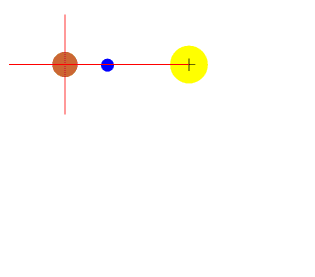
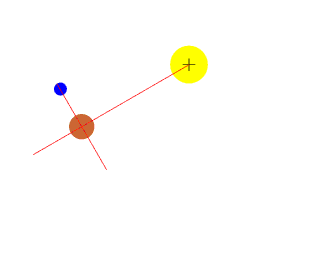
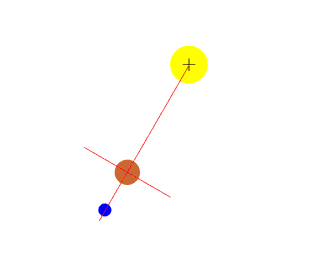
The Moon goes round the Earth about once every 28 days, but because during this time the Earth will have moved a little round the Sun we actually get a New Moon about every 29½ days. A Lunar Month is therefore either 29 or 30 days long: this is discussed in the Page on Lunar Months.
The Moon Bulges are about three times as big as the Sun Bulges. At New Moon and Full Moon the Sun Bulges and the Moon Bulges coincide, so we get extra high High Tides, and of course extra low Low Tides. These are the Spring Tides. At the First and Third Quarters the Sun Bulges and Moon Bulges are at right angles to each other so there is much less difference between High Tide and Low Tide. These are the Neap Tides. There are two Spring Tides every lunar month so we usually get one about every 15 days.
We usually say the Earth goes round the Sun in a circle, but it is actually an ellipse, with the Sun at one focus. This means that the distance of the Sun from the Earth is not constant. The nearest approach of the Earth to the Sun is called perihelion. This is further discussed in the Page on The Orbit of the Earth.
Similarly the Moon’s orbit is also an ellipse, and its nearest approach to the Earth is perigee. This means that there are small variations in the distances of the Sun and Moon from the Earth, and so in the size of the Bulges and height of the tides. If the Earth is at perihelion and the Moon is at perigee and the Moon is New all at the same time we shall get extra high High Tides.

Every drop of water, even the water in your bath, is acted upon by the same forces that produce the tidal bulge. The forces act right through the water from the top to the bottom, so the deeper the water the bigger the bulge. In the deep oceans, a long way from land, the bulge is about 500 mm, but it is rather less than this in your bath (fortunately). However, the bulge in the oceans moves round the Earth from East to West and as it reaches shallower water, or any sort of land mass, the height of the bulge will be increased. Also the bulge reaches different parts of the coast at different times so there can be tidal currents along the coast, and in particular around and between islands.
Because it is almost totally enclosed the Mediterranean Sea has only very small tides, and only a small variation between Spring and Neap tides, whereas the Atlantic Ocean has much larger tides and much greater variation. (This caught out Julius Caesar, see the next Paragraph, on Tidal Surges.)
You really need an atlas, or better still a globe, to appreciate what follows. The tides move round the Earth from East to West. Millions of years ago North and South America were separate land masses and water could flow between them, and also round Northern Canada, but now it can only flow through the gap between South America and Antarctica. This means that the greatest tidal currents are off Cape Horn and the highest tides are on the Eastern coast of Canada: in the Bay of Fundy they can reach 15 m. (The melting of the Arctic ice cap will once more allow water to flow round Northern Canada and this will have a significant effect on tidal patterns.)

Atmospheric pressure pushes down on the seas and oceans, and this means that if the atmospheric pressure is very low in one area water may be pushed into it from areas of higher pressure, raising the sea level. Low pressure is associated with stormy weather. Although this does not affect the tides it does mean that in stormy weather at High Tide the water level is higher than usual. The winds may also cause rough seas and high waves, and if the wind blows for a long time in the same direction large volumes of water may be driven into an estuary or other confined space. The North Sea is very sensitive in this respect to strong continuous winds from the North West. If all of these come together at the time of a New Moon or Full Moon we have a storm surge.
Storm surges affect only the top few metres of the sea near coastal regions and estuaries, they do not affect the water in the deep oceans.
In January 1953 a very severe storm surge caused widespread flooding, damage and loss of life along the East Coast of England; in November 2007 an almost identical storm surge produced very similar water levels, but the people had had more warning and were better prepared, and it passed without causing more than very local flooding.
In the late Summer of 55 BCE Julius Caesar and his Roman army landed in Britain for the first time, on the East Coast of Kent, but they nearly lost all their ships in a storm surge. This is a very interesting story and you can read Caesar’s own account of it here.

The Earth is rotating on its axis about once every twenty four hours. This means that, in effect, every drop of the water in the oceans is in orbit round it. The speed of the water is greatest at the equator and zero at the poles so there is a bulge at the Equator. This does not of course affect the tides because it goes all the way round the Earth and rotates with it.
Up till now we have considered that the Earth is a rigid sphere but this is not quite the case. There is also a bulge of the whole Earth at the Equator: the Earth is not a sphere but what mathematicians call an oblate spheroid.
Going one stage further, there are also tides, Earth Tides, in the Earth in exactly the same way as there are tides in the oceans, athough they are not quite as big, up to about 400 mm, and we do not notice them. But they are very important indeed to seismologists (people studying earthquakes) and other people studying the Earth's crust.
The friction of the tides has already slowed the rotation of the Moon on its axis down to the point at which it is locked to the Earth: this means that the same side of the Moon always faces the Earth. Tidal friction is also very gradually changing the rate at which the Earth rotates on its axis and goes round the Sun, and the rate at which the Moon goes round the Earth.
There is a much more complete but very technical discussion on all of this on the International Earth Rotation and Reference Systems website.

All living things depend upon the tides, even those in the deep oceans and on land hundreds of kilometres from the sea.
In the deep oceans the only producers are the phytoplankton, the tiny plants in the plankton layer. Every food chain starts there, but some of the detritus (bits of dead things) in the oceans falls to the bottom of the ocean, and so the minerals in them are not returned to the water near the surface when they decompose. The waters near the surface of the deep oceans are therefore very deficient in the minerals, particularly iron, needed by phytoplankton, and so support very little life. This is discussed in more detail on the Plant Nutrition Page.
The ebb and flow of the tides and the tidal currents in the shallower water surrounding the continents and islands keep the nutrients circulating and so provide much better conditions for life to thrive: shallow coastal waters and estuaries teem with life of every sort from seaweeds and sea grasses and corals to tiny shellfish and whales, and of course seabirds by the million.
The tides cause mixing of the shallow coastal waters and the water from the deep oceans, and many living creatures move freely between the shallow coastal waters and the waters of the deep oceans taking essential nutrients with them.
Rain falling on the land washes minerals out of the soil and rivers carry them, and also particles of soil, out to the coast. The sea weeds and sea grasses take up these minerals and also prevent the solid particles from being washed out into the oceans where they would just become ocean sediments. Then these plants return the minerals to the land, in many different and wonderful ways, some at present barely understood.
For example, all living things need iodine, but iodine compounds are very soluble in water and so easily washed out of the soil and carried to the coast by rivers. Coastal waters are therefore very rich in iodine. Sea grasses take up this iodine. Then they release it into the atmosphere (only by day when they are photosynthesising, when the land is warmer than the sea and so the winds blow off the sea onto the land) in the form of methyl iodide vapour, which is carried back onto the land by the winds and washed out of the air by rain hundreds of kilometres from the sea.
These tidal waters and estuaries round the continents and islands are enormously important to all life on land and in the seas and oceans, and it is very important that we do nothing to harm them.

There are two main ways we can harness the energy of the tides.
The first is to use tidal currents. You find a place, typically between two islands, where there is a strong tidal current, and put in a turbine, rather like an underwater wind turbine, except that the tides are much more reliable and much more predictable than the wind. There is a lot of very exciting work on tidal current turbines being done in the Orkneys, but unfortunately the Government’s preferred option is wind turbines and there is a very real danger that Britain might lose her lead in tidal current technology. Tidal current turbines do not stop the tidal currents any more than wind turbines stop the wind, so they do not pose a significant ecological threat.
The second way is to find an area where the tides flow into an enclosed area such as a bay or estuary and build a tidal barrage (long dam). So far the only tidal barrage built to produce electricity is on the River Rance, near St Malo in France. Here the tides can reach 8.5 m.
The ideal site for a tidal barrage in Britain, in fact the whole World, is on the River Severn, near Bristol. Here the tides can reach 12 m, the second highest tides in the World after Fundy. There has been talk of building a Severn Barrage since the 1930s.
The problem with building a tidal barrage here is that the same reasons which make it the ideal site for a tidal barrage also make it the ideal habitat for all the animals and plants that call it their home, an area of outstanding natural beauty, and a site of special scientific interest. A tidal barrage here would cause great damage to the environment. Much more seriously, wind farms or tidal current turbines or solar cells or hydro-electric power stations are reversible: if you do not like them you can take them down and restore the land or sea to its original state. But a tidal barrage is irreversible: once it has been built the environmental changes that it brings cannot be undone. We should not build a tidal barrage here unless we are absolutely certain that it meets a need, a long-term need, which cannot be met in any other way.
